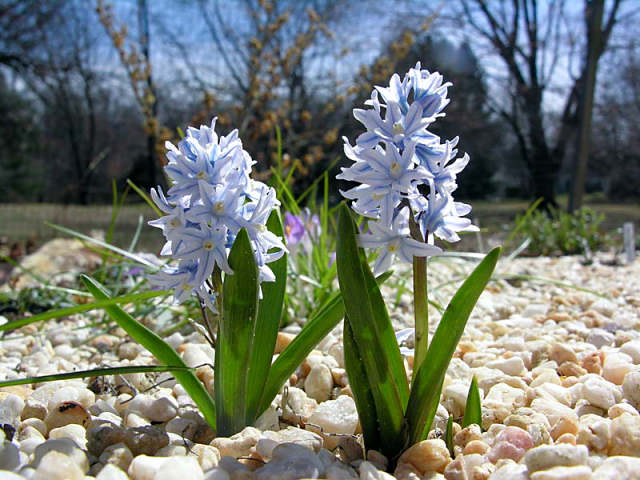By Pat Curran
Question: Which spring-flowering bulbs are easy and reliable?
Answer:
It’s barely August, but yes, it’s time to think about where to add spring bulbs to the garden. Having returned from vacation, I have been busy weeding the flower and shrub beds. I have never seen Narcissus (daffodil) foliage still green in early August before. I have been ruthlessly cutting it down while I weed and mulch. However, lingering Narcissus foliage is something to consider. It’s often green until early July, and one is not supposed to tie it up or remove it before then. It’s not really unsightly, but it certainly makes maintenance harder. Now I am paying even more attention to bulbs that mature their foliage quickly.
 |
| Puschkinia, 2014 |
Early spring bulbs that naturalize (spread by seed) well and go dormant soon after blooming include Siberian squill (closest to a true blue, and also available in white), glory-of-the snow (lavender-blue, pink, or white), and Puschkinia (white flowers with turquoise stripes). These are all small plants suitable for the front of the border. If you have a shady lawn under deciduous trees, they will do well there planted in the thin grass. Anemone blanda is a delightful little naturalizer. Flowers in blue/purple, pink, or white, attractive ferny foliage, long bloom time, and animal resistance all combine to make it a great edging for a flower bed. Grecian windflower is not a true bulb; instead, it has odd-shaped dark little tubers. Soak them briefly in warm water before planting, and don’t worry about which side of the tubers is up.
Spanish bluebell is a late spring bloomer that multiplies well. Tolerant of partial shade, it blooms in lavender-blue, pink, or white. Like most bulbs, it is more effective in the landscape in groups of a single color. When I moved a Hosta last year, I was just stunned by the number of nearby bluebell bulbs I found. The taxonomists keep changing the scientific name, but the most recent version is Hyacinthoides hispanica.
Fritillaria meleagris, the checkered lily or guinea hen flower, is a small plant with narrow inconspicuous foliage. The flowers are drooping bells either in mauve with a checkerboard effect, or all white. Plant this one where it will be easily seen up close. Native to western Europe, the checkered lily is happy in partial shade and will also naturalize. The bulbs, however, are delicate, relatively soft and fleshy. Plant them immediately as they are prone to drying out.
Look for Narcissus ‘Hawera,’ a smaller variety. A charming May bloomer, its narrow leaves go dormant relatively quickly. Plant in the front where it can be appreciated.
Ask a Gardener appears weekly in The Journal during the growing season. For answers to other garden, lawn, landscape and pest questions, call Cooperative Extension at 607-272-2292 or email: growline1@gmail.com. This article was written by Patricia Curran, horticulture program manager at Cornell Cooperative Extension of Tompkins County.
No comments:
Post a Comment